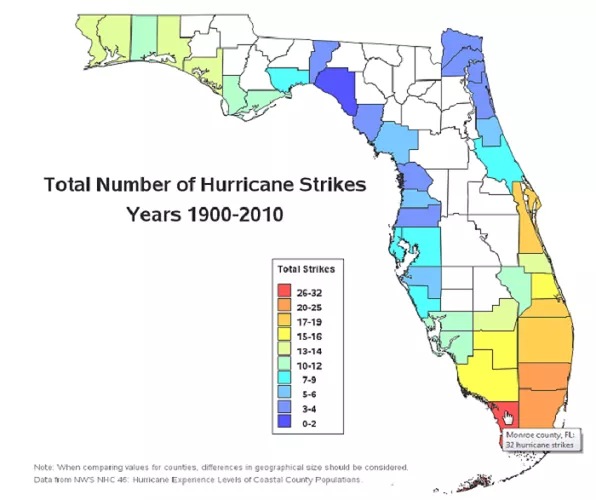Florida is one of the most hurricane-prone states in the United States. Its unique geographic location, surrounded by the Atlantic Ocean to the east and the Gulf of Mexico to the west, makes it a prime target for tropical storms and hurricanes. But just how many hurricanes have hit Florida over the years? In this article, we’ll explore Florida’s hurricane history, the frequency of these storms, and their impact on the state. Whether you’re a resident, planning to move to Florida, or just curious, this guide will provide a comprehensive overview of Florida’s hurricane activity.
Why Is Florida So Vulnerable to Hurricanes?
Before diving into the numbers, it’s important to understand why Florida is so susceptible to hurricanes. Here are the key reasons:
1. Geographic Location: Florida is a peninsula, meaning it is surrounded by water on three sides. This makes it a natural target for hurricanes forming in the Atlantic Ocean and the Gulf of Mexico.
2. Warm Waters: Hurricanes thrive on warm ocean water, and both the Atlantic and Gulf provide the ideal conditions for storm formation.
3. Flat Terrain: Florida’s flat landscape offers little resistance to hurricanes, allowing them to maintain their strength as they move inland.
These factors make Florida one of the most hurricane-affected states in the U.S.
How Many Hurricanes Have Hit Florida?
Florida has a long history of hurricanes, dating back to the 16th century. According to the National Oceanic and Atmospheric Administration (NOAA), Florida has been hit by over 120 hurricanes since record-keeping began in 1851. Of these, 40 have been major hurricanes (Category 3 or higher). This means Florida averages about 1.5 hurricanes per year, with a major hurricane hitting the state approximately once every 4 years.
Here’s a breakdown of Florida’s hurricane history:
- Total Hurricanes: 120+
- Major Hurricanes (Category 3+): 40+
- Most Active Decades: The 2000s and 2010s saw some of the most active hurricane seasons in Florida’s history.
Notable Hurricanes in Florida’s History
Florida has experienced some of the most destructive hurricanes in U.S. history. Here are a few of the most notable ones:
1. The Great Miami Hurricane (1926)
- Category: 4
- Impact: This hurricane caused widespread destruction in Miami, killing over 370 people and causing billions in damages (adjusted for inflation).
2. Hurricane Andrew (1992)
- Category: 5
- Impact: Andrew devastated South Florida, causing $27 billion in damages and leaving thousands homeless. It remains one of the costliest hurricanes in U.S. history.
3. Hurricane Charley (2004)
- Category: 4
- Impact: Charley caused significant damage in Southwest Florida, particularly in Punta Gorda and Port Charlotte.
4. Hurricane Irma (2017)
- Category: 4
- Impact: Irma affected nearly the entire state, causing widespread flooding, power outages, and billions in damages.
5. Hurricane Michael (2018)
- Category: 5
- Impact: Michael was the first Category 5 hurricane to hit the Florida Panhandle, causing catastrophic damage in Mexico Beach and surrounding areas.
Which Parts of Florida Are Most Affected?
While hurricanes can impact the entire state, some regions are more vulnerable than others:
1. South Florida: Miami, Fort Lauderdale, and the Florida Keys are frequently hit due to their proximity to the Atlantic Ocean.
2. Southwest Florida: Cities like Naples, Fort Myers, and Tampa are at risk from Gulf Coast hurricanes.
3. Florida Panhandle: This region, including Panama City and Pensacola, is often affected by hurricanes forming in the Gulf of Mexico.
4. Central Florida: While less frequently hit, Central Florida can still experience significant impacts from hurricanes moving inland.
The Economic Impact of Hurricanes in Florida
Hurricanes have a significant economic impact on Florida. Here are some key points:
- Property Damage: Hurricanes can cause billions of dollars in property damage, particularly in coastal areas.
- Insurance Costs: Florida has some of the highest homeowners’ insurance rates in the country due to hurricane risk.
- Tourism: Hurricanes can disrupt Florida’s tourism industry, which is a major contributor to the state’s economy.
- Agriculture: Florida’s agriculture sector, including citrus crops, can be severely affected by hurricanes.
Climate Change and Future Hurricane Activity
Climate change is expected to influence hurricane activity in Florida. While the number of hurricanes may not increase, their intensity and rainfall potential are likely to rise. Warmer ocean temperatures and higher sea levels could lead to more powerful storms and greater flooding risks.
Conclusion
Florida’s hurricane history is both fascinating and sobering. With over 120 hurricanes hitting the state since 1851, including 40 major hurricanes, Florida is no stranger to these powerful storms. From the Great Miami Hurricane of 1926 to Hurricane Michael in 2018, these events have shaped the state’s history and resilience.
Understanding Florida’s hurricane activity is crucial for residents, policymakers, and anyone considering moving to the Sunshine State. By staying informed and prepared, Floridians can continue to weather the storm and thrive in this beautiful but hurricane-prone region.

